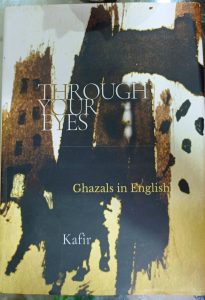History has abundant examples of cultural crossovers. With the movement and intermingling of cultures, there has been a movement of literary forms too, across languages and cultures. That is the reason that we could find sonnet travelling from Italian to English to Bangla and haiku travelling from Japan to various countries of Europe and Asia. Ghazal is another very old form of poetry that has a long history of travel and adaptation. Poet and scholar Anisur Rahman[i] has traced this journey of ghazal from the Arabic peninsula to various parts of the world including medieval Spain and Western Africa. It also reached Persia where it developed its distinct characteristic. It was the form popular in Persia that dominated the poetic form in India and other Asian countries. English ghazal comes much later. Initially, there were various experiments with the form, till Agha Shahid Ali gave it a proper structure. But ghazal as a form has continued to intrigue poets in various languages. Poets have kept on experimenting with the form, trying to find the style best suited for their expressions. Though primarily considered to be revolving around the theme of love, ghazals have included versatile expressions of mysticism and protest too within their forms.
 Through Your Eyes, a collection of English ghazals by Rajorshi Patranobis, published from Haoajan in 2021, is an experiment with the form of ghazal. Kafir, the poetic persona in this anthology, walks us through a medley of emotions as he breezes his way through page after page. The name Kafir is also intriguing. Kafir is the ‘non-believer’, in the Islamic tradition, he is the one who does not believe in the existence of God. Here, Kafir is the one whose only religion is love. There is an interplay with various shades of love – passion, anxiety, sensuality, spirituality, possessiveness, separation, among others. There is rich sensuality in the opening poem of the anthology, which also shares the title of the anthology
Through Your Eyes, a collection of English ghazals by Rajorshi Patranobis, published from Haoajan in 2021, is an experiment with the form of ghazal. Kafir, the poetic persona in this anthology, walks us through a medley of emotions as he breezes his way through page after page. The name Kafir is also intriguing. Kafir is the ‘non-believer’, in the Islamic tradition, he is the one who does not believe in the existence of God. Here, Kafir is the one whose only religion is love. There is an interplay with various shades of love – passion, anxiety, sensuality, spirituality, possessiveness, separation, among others. There is rich sensuality in the opening poem of the anthology, which also shares the title of the anthology
“Your fragrance swoons
Your notion falls and rise
Let me drink through your eyes
You fondle my heart
Play with my veins
Moans give way to heavenly sighs
Let me drink through your eyes” (11)
Sensuality mingles with spirituality as Kafir finds his heaven in the eyes of his beloved. The poet does not limit himself stylistically and the couplets are often broken lines or short phrases, communicating with a kind of restless energy that is very much a signifier of the heterogeneity of perspectives of a post-humanist world:
Myriad sounds of grey
Games that night play
Was it lust or love
Or may be both,
Wasn’t it that pain
Silently pinches to stay?
Myriad sounds of grey. (Games, 22)
In Kafir’s journey through love, there is a sense of ‘absolute abandonment’, as rightly pointed out by Tania Chakravertty in her blurb. In his ecstasy, poetry and beloved merge together, as does his sense of present and past.
“Poetry loses in you, its presence
Look into me, listen to my silence.
Lived through you
Slept in you
Cuddled you in my dreams
Your smile spoke to me.” (Silence, 48)
The silence is voluble. Kafir ‘screams in ecstasy’. Yet, in insomniac nights, there is a disquiet in him to talk to his beloved,
“Kafir slaps himself
Painful dreams break to pieces
Silence broke to your moan
Words eluded
Pin drop knock
Happily waited, for you to talk.” (Talk, 45)

Kafir stumbles, lose his way, and yet again finds his way back. The goal remains steady. In ‘Lost Address’ the first and the last stanza beautifully captures this sense of confusion and clarity –
Winding through anomalies
Smell leaves trace
Your lost address.
And then, a few lines later, there is a way out of the confusion, heaven directed clarity in perception –
Kafir prays again
Heavens irrigate
Sees across haze
Your lost address. (Lost Address, 18)
In Kafir’s world, colours play a very important role. In the ghazal titled ‘Red’ he seeks ways and means to colour his ‘love in red’, a colour that stands for passion, blood, and love itself. This poem reminds me of Kafir’s small note to readers where he states that he is a poet who writes with his blood. But red is not the only colour in his canvas. There is ‘orange’ that ‘savours [the] lips’ and ‘diamond studded green in jade’ – colours that stand for various attributes of his beloved – parts that he attempts to stitch into one whole. In another poem titled ‘Blue’, we once again meet a palette of various colours. Purpled coloured heart is juxtaposed against the painted blue sky while the smile that he smiles in his grave is ‘ashed’. Love is represented as a transcendent feeling, cutting through the boundaries of time, space and even life.
The anthology, like its very creator, Kafir, breaks through tradition. Love, passion and imagination seem to cut across all the rules of life and form. In Kafir’s own words, “I am a Kafir who loves, who believes, who prays” (10); a perspective different from that of the traditional non-believer. His god is the one who rules his heart, and that is his religion. In a very detailed foreword that also traces the history of English ghazals, Ayaz Rasool Nazki ends by saying,
“Poetry is the art of discovery and good poetry discovers a song hidden under the pebbles in a dry stream…Rajorshi is on a voyage across the horizons, oceans and deserts. He brings the fragments of those stories and skillfully weaves them into the gazal, that ‘half-wild’ genre of fragmented thoughts.”
That is the best way, to sum up, Rajorshi Patranabis’ poems. The purists may argue whether the ghazals anthologized in this volume are structurally true to their form or not, Rajorshi Patranabis definitely captures the spirit of this beautiful and timeless poetic genre. While, on the one hand, he brings in certain innovations and variations in the form, he also captures the essence of love, mysticism and passion which have been traditionally associated with this genre. Kafir takes along his readers on a journey of his heart and through his poems, they too become engaged in his quest.
[i] https://scroll.in/article/908670/how-the-ghazal-traveled-from-6th-century-arabia-to-persia-india-and-the-english-speaking-world









An outstanding review of the book that is extremely mesmerizing….